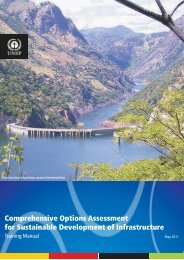MEASURING WATER USE IN A GREEN ECONOMY - UNEP
MEASURING WATER USE IN A GREEN ECONOMY - UNEP
MEASURING WATER USE IN A GREEN ECONOMY - UNEP
Create successful ePaper yourself
Turn your PDF publications into a flip-book with our unique Google optimized e-Paper software.
Measuring water use in a green economy<br />
Figure 3.1, however a static model is shown,<br />
not including the time-space variability of the<br />
water cycle impacted by climate change. In a<br />
further development of Figure 3.1, blue water<br />
resources are referred to as the sum of surface<br />
and groundwater; green water resources are<br />
referred to as rainwater insofar as it does not<br />
become run-off.<br />
The large differences in residence times make<br />
it necessary to address the stocks and flows<br />
from the perspective of their potential use.<br />
Residence time is an intriguing indicator. It<br />
expresses the claim that a storage project<br />
makes into the future, as a kind of temporal<br />
footprint. It also expresses, in a temporal<br />
unit, its spatial dependency and area of<br />
influence. ‘The larger the residence time<br />
of a reservoir, the greater its dependence<br />
on the water resources generated in the<br />
upstream catchment area, and the larger the<br />
impacted area downstream [cf. Vörösmarty<br />
et al., 1997].’ Van der Zaag and Gupta, 2008).<br />
Large reservoirs and their operations for<br />
agriculture and hydropower can cause large<br />
changes in flow regime which can be a major<br />
cause of ecosystem degradation. There is no<br />
simple method to depict the complexity of the<br />
situation. The role of all quantification methods<br />
included here is to present the balances at<br />
levels of temporal and spatial disaggregation<br />
that are practically useful (both in themselves<br />
and in supporting other methodologies). They<br />
should be as free as possible from misleading<br />
errors resulting from misunderstanding of the<br />
flux and stock issues, and they should specify<br />
the location of water consumption and the<br />
(potentially distant) location of impact or water<br />
stress.<br />
This report uses terminology derived from<br />
the International Recommendations for<br />
Figure 3.1<br />
Figure 3.1<br />
Simplified water budget at a river basin scale<br />
Simplified water budget at the river basin scale<br />
Actual<br />
Evapotranspiration<br />
(ET a)<br />
Precipitation<br />
Actual<br />
External Inflow<br />
(Qi) (SW+GW)<br />
Imports / Exports /<br />
Returned Flow<br />
SW Inflow<br />
Agriculture<br />
Streamflow<br />
Total Actual Outflow (SW+GW)<br />
(Qo = Qo,s + Qo,n)<br />
Qo,n<br />
into neighbouring<br />
Public water<br />
supply<br />
Reservoir<br />
Storage<br />
Industry<br />
Qo,s into the sea<br />
GW Inflow<br />
SW Outflow<br />
River Basin - RB<br />
Other<br />
Water Abstractions<br />
GW Storage<br />
GW level<br />
Major Aquifer System - MAS<br />
GW Outflow<br />
35

















